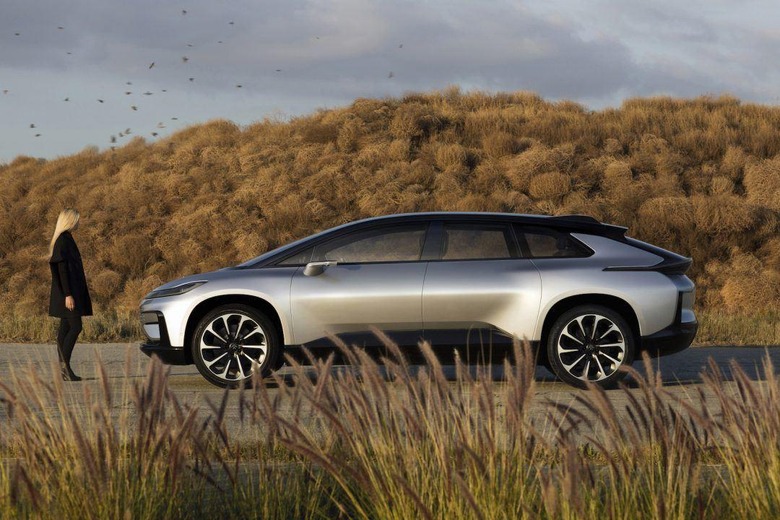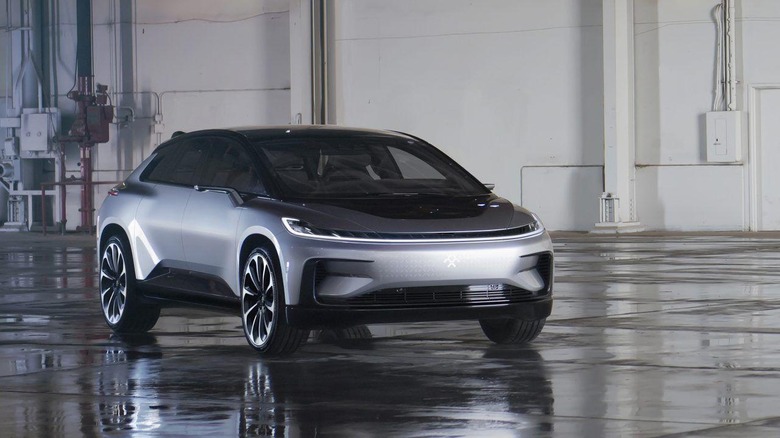Faraday Future FF 91: Five Things You Need To Know
If Faraday Future's 2016 CES was shaky, with a last-minute prototype wheeled out instead of the electric car the company had intended to show, then CES 2017 has proved far more dramatic. The freshly-unveiled FF 91 has everything you need from an EV aiming to show up the gas-powered mainstream: sky-high power figures, big range claims, and the sort of technology that you'd expect from Silicon Valley players turned automakers. Here are five big things you need to know.
It's design is... controversial
Say what you will about Tesla, the Model S is – even several years old – still a striking sedan. Faraday Future's car isn't quite so aesthetically appealing at first glance, partly by design and partly as a side-effect of what the automaker wanted to achieve. Either way it's been enough to divide opinion from the get-go.
Somehow mixing both minivan and coupe cues in the same vehicle, it's long and low. That means plenty of interior space – helped by the Faraday's electric drivetrain being a "sled" atop which the bodywork sits – that should come in handy as you're lolling around with the FF 91 in autonomous mode. Still, it's probably not going to win any style awards.

There are dozens of sensors
The modern car isn't short on sensors but the FF 91 takes that to another level. Ten cameras surround the EV, along with 13 radars – a mix of short and long distance – and twelve ultrasonic sensors. There's even a LIDAR scanner, that rises up like a totem pole from the hood when the car is in autonomous mode.
They're all used for tracking other vehicle and pedestrians around the car, but inside the FF 91 is keeping tabs on the driver too. While seats that can be programmed to recall certain settings aren't new, Faraday Future says its EV doesn't need the initial teaching. Instead, it'll observe the preferences of the driver and remember them, automatically tuning the cabin according to what it has learnt whenever someone it recognizes returns to the car: some of those cameras will offer facial and iris recognition too.
It's going to be fast
Electric cars don't need to be slow. Tesla wasn't the first to demonstrate that, but it has certainly hammered the point home with increasingly potent versions of its cars. That's given Faraday Future a good target to aim for, and sure enough the FF 91 should – on paper at least – out-perform Elon Musk's finest.
The powertrain will have a hefty 1,050 horsepower, which Faraday Future says is good enough for a 2.39 second 0-60 mph time. Torque isn't confirmed yet, but we already know that the great thing about electric drivetrains is that their torque arrives instantly. The FF 91 had a drag race showdown with some high-profile rivals on-stage and, though it was hardly scientific and took place on a less-than-ideal surface, just snuck in under the Tesla's time.
It'll have top-notch range
How far you can roam off the charger is the big question all EVs face, and Faraday Future has some big claims there, too. According to the company, on a full charge the FF 91 will run for 378 miles on the EPA cycle (or over 700 km on the NEDC cycle). An hour on the charger will be enough for more than 500 miles of top-up.
That's down to a 130 kW battery, which is a fairly rare thing in the automotive world right now. Tesla's current biggest battery is the 100 kW pack found in the P100D; late last year another electric car upstart, Lucid Motors, promised its car would have a 130 kW option, though its Air EV would launch with a 100 kW pack first. Elon Musk has previously warned that moving higher up in battery capacity will demand exponentially greater amounts of work.

"The difficulty of increasing the energy in the pack is truly non-linear with increasing the energy," the Tesla CEO said last year, when the 100 kW Tesla battery was announced. "Although it may be a 11- or 12-percent increase in capacity, it's really been a 50-percent increase in difficulty." Musk later suggested that fundamental changes in cell chemistry would be required for future increases.
Does that mean Faraday Future can't deliver on a 130 kW pack? Not necessarily, but it's likely to be a low-volume option and we'd not be surprised if only a minority of the cars it produces offer quite that large a battery. As Tesla has discovered over the past years, battery supply can be quite the bottleneck to your production plans.
It's nowhere near ready yet - or even entirely ready for demos
The demo Gods are cruel, and if something can possibly go wrong during your flashy presentation, it probably will. All the same, Faraday Future's embarrassing flop during one of the car's headline features is likely to haunt it for some time to come. In theory, the FF 91 can drive itself off, park up, and then return to you later on, all of its own accord.
In reality, the electric car simply refused to play ball. The automaker later blamed the venue for interfering with some of the FF 91's sensors, and on a second attempt it duly trundled off to park itself. All the same, it's a sharp reminder that automotive technology really isn't as easy as some might hope.
Wrap-Up
There's a fair amount of skepticism around the FF 91, and much of it is deserved. Faraday Future hasn't been shy about its publicity claims, and bringing Ferraris and Bentleys on-stage at your electric car launch is a good way to get attention – but also to cover up some of the glaring questions that remain. We still don't know how much the FF 91 will cost, over and above the $5k deposit the automaker is taking to secure a place in line, for instance.
More importantly, all is not necessarily smooth sailing within the business. Issues with funding – Faraday Future is bankrolled by Le Eco, which has had a shaky 2016 – and losses of high-profile personnel after what seemed like talent after talent joining the start-up have given many pause for thought. Throw in an ambitious 2018 production start, at least according to execs at the firm, and there really are more questions than facts at this point.
The electric car industry may probably get a zero-emissions sedan capable of embarrassing supercars, but it's not clear whether Faraday Future will be responsible for it.
